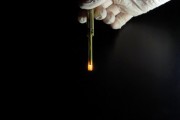 2014-09-22
2014-09-22
University of Utah physicists read the subatomic “spins” in the centers or nuclei of hydrogen isotopes, and used the data to control current that powered light in a cheap, plastic LED – at room temperature and without strong magnetic fields.
Continue reading →
 2014-09-22
2014-09-22